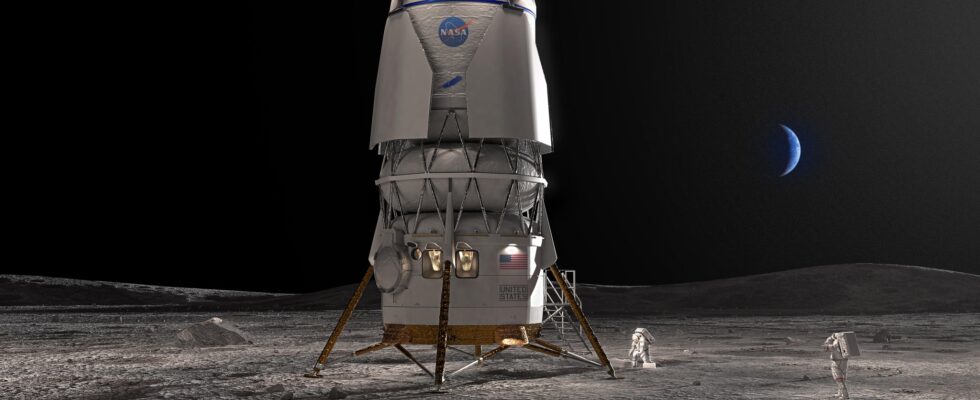Two years later SpaceX’s selection and its Starship, NASA chooses Blue Origin’s lunar lander to embark the astronauts of its mission Artemis V on the surface. A political decision at 3.4 billion dollars, which will stimulate competition between these two giants of the American space field.
Blue Origin’s proposal incorporates elements from many companies, pillars of the sector.
Blue Moon wins first prize
This Friday, May 19, NASA had put the dishes in the big ones, to announce the winner of its second selection for a lunar lander. It’s Blue Origin’s Blue Moon project that hits the jackpot, with $3.4 billion in funding by 2029 and a dedicated mission with astronauts, Artemis V. This vehicle, whose engines will run on hydrogen and oxygen, will take over from Starship, and will even be the competitor of SpaceX’s large vessel for the following missions.
Back to a complex selection…
Two different lunar landers? This is a NASA decision and selection process that perhaps needs to be explained. Indeed, the American space agency, within the framework of its gigantic Artemis project to return to set foot on the Moon, has decided to appeal directly to the national aerospace giants to sign “public-private” contracts, to which NASA agrees to be a client at a high price, but the industrialists must invest on their side. In 2020, NASA conducted a first call for tenders, to which four candidates responded: Dynetics (allied to Sierra Nevada), the “National Team” (Blue Origin, Lockheed Martin, Draper, etc.), Boeing and SpaceX. SpaceX’s Starship won the competition, and NASA immediately ordered a demonstration flight and two missions to bring astronauts to the lunar surface: Artemis III in 2021 and Artemis IV in 2022.
But this choice had raised many objections. First from Blue Origin, which contested the selection on the basis of technical feasibility: the Starship must be refueled in Earth orbit many times before reaching the Moon: it is a huge and complex vehicle and NASA has chosen to trust an industrialist who promises to use many elements that have not yet been tested. Blue Origin lost its case against NASA, but the latter had a political echo, and six months later the United States Congress (which controls the purse strings of the national agency) asked for a new selection to dispose of a competitive process. A second lunar lander has also been developed with several billion public dollars, two suppliers being better than one and competing from the Artemis VI mission.
NASA had saved its image by arguing that this new contract was different, wanting a “reusable and durable” vehicle… SpaceX being already selected, there were two filings. Dynetics (this time with Northrop Grumman) and Blue Origin, keeping its National Team partners but applying on its own behalf with its Blue Moon vehicle. It is therefore the company established by Jeff Bezos that won this new selection. And his reusable vehicle is much bigger than in the previous proposal!
Next to him, the LEM is very small…
If it is smaller than the Starship, Blue Moon is not a small vehicle… It just fits under the fairing of a New Glenn rocket (Blue Origin) with 7 meters in diameter and 16 meters high, for 16 tons empty (45 with its propellants). Once in Earth orbit, Blue Moon will be transported to lunar orbit after meeting with a specific vehicle developed by Lockheed Martin, a sort of inter-orbital cargo ship. Then it can stay for several months waiting for a crew or a cargo ship to descend on the lunar surface, thanks to an innovative cooling technology which aims to avoid the usual pitfalls of liquid hydrogen (very efficient propellant but very little dense, and which evaporates quickly if it is not refrigerated at very low temperature). The lander also surprises with its shape, with its tanks on top and its compartment dedicated to astronauts on the bottom!
Being a private lander (NASA finances but it is “only” a client), Blue Origin also reserves the right to sell lunar tickets to other entities or people… which could ultimately favor nations that do not have the means to develop this type of technology, like what is being done today with SpaceX’s Crew Dragon capsule. Still, this announcement and these big resources have been making a lot of noise since Friday: despite many promises, strong partners and thousands of employees, Blue Origin still has everything to prove in the space field…
Source : nasa

10